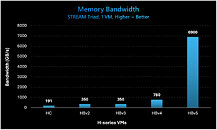- Joined
- Aug 19, 2017
- Messages
- 2,999 (1.07/day)
Microsoft has announced its new Azure HBv5 virtual machines, featuring unique custom hardware made by AMD. CEO Satya Nadella made the announcement during Microsoft Ignite, introducing a custom-designed AMD processor solution that achieves remarkable performance metrics. The new HBv5 virtual machines deliver an extraordinary 6.9 TB/s of memory bandwidth, utilizing four specialized AMD processors equipped with HBM3 technology. This represents an eightfold improvement over existing cloud alternatives and a staggering 20-fold increase compared to previous Azure HBv3 configurations. Each HBv5 virtual machine boasts impressive specifications, including up to 352 AMD EPYC "Zen4" CPU cores capable of reaching 4 GHz peak frequencies. The system provides users with 400-450 GB of HBM3 RAM and features doubled Infinity Fabric bandwidth compared to any previous AMD EPYC server platform. Given that each VM had four CPUs, this yields 88 Zen 4 cores per CPU socket, with 9 GB of memory per core.
The architecture includes 800 Gb/s of NVIDIA Quantum-2 InfiniBand connectivity and 14 TB of local NVMe SSD storage. The development marks a strategic shift in addressing memory performance limitations, which Microsoft identifies as a critical bottleneck in HPC applications. This custom design particularly benefits sectors requiring intensive computational resources, including automotive design, aerospace simulation, weather modeling, and energy research. While the CPU appears custom-designed for Microsoft's needs, it bears similarities to previously rumored AMD processors, suggesting a possible connection to the speculated MI300C chip architecture. The system's design choices, including disabled SMT and single-tenant configuration, clearly focus on optimizing performance for specific HPC workloads. If readers can recall, Intel also made customized Xeons for AWS and their needs, which is normal in the hyperscaler space, given they drive most of the revenue.


View at TechPowerUp Main Site | Source
The architecture includes 800 Gb/s of NVIDIA Quantum-2 InfiniBand connectivity and 14 TB of local NVMe SSD storage. The development marks a strategic shift in addressing memory performance limitations, which Microsoft identifies as a critical bottleneck in HPC applications. This custom design particularly benefits sectors requiring intensive computational resources, including automotive design, aerospace simulation, weather modeling, and energy research. While the CPU appears custom-designed for Microsoft's needs, it bears similarities to previously rumored AMD processors, suggesting a possible connection to the speculated MI300C chip architecture. The system's design choices, including disabled SMT and single-tenant configuration, clearly focus on optimizing performance for specific HPC workloads. If readers can recall, Intel also made customized Xeons for AWS and their needs, which is normal in the hyperscaler space, given they drive most of the revenue.


View at TechPowerUp Main Site | Source






